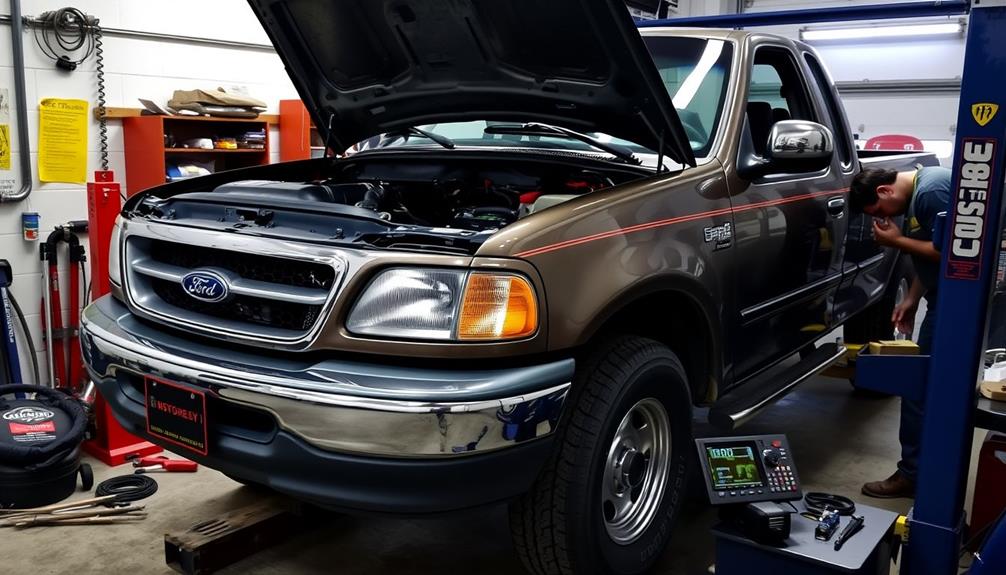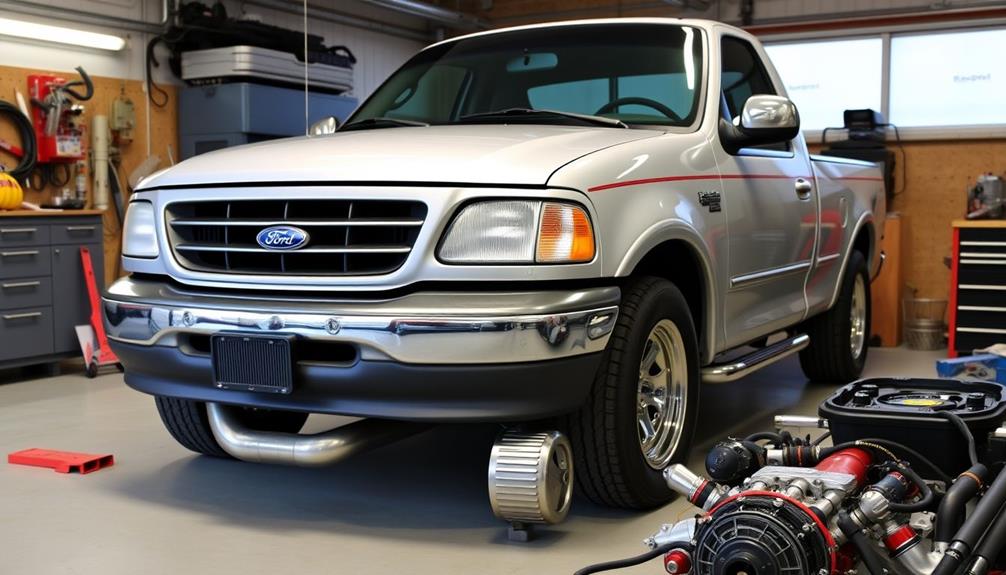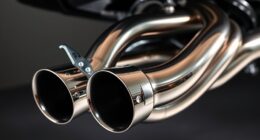Tuning your 2000 Ford F-150 can release modern power and performance you didn't think possible. Start with high-performance exhaust systems to boost horsepower and enhance sound. Using SCT tuners can give you an easy power gain of 11-14 HP and improved torque. Custom tuning might even reveal an impressive 70-80 HP boost! Simple DIY maintenance like replacing air and fuel filters also helps restore engine efficiency. And don't underestimate community insights; connecting with fellow F-150 enthusiasts can uncover budget-friendly modifications. Stick around, and there's plenty more to discover about maximizing your classic truck's capabilities.
Key Takeaways
- Upgrading to high-performance exhaust systems can significantly boost horsepower and enhance the sound of your 2000 F-150.
- Using SCT tuners allows for real-time adjustments, yielding gains of 11-14 HP and improved torque for your classic truck.
- Custom tuning may reveal substantial power increases of 70-80 HP, optimizing performance with stock components.
- Regular maintenance, including replacing air and fuel filters, restores engine performance and prepares it for modern enhancements.
- Engaging with F-150 owner communities provides valuable insights on budget-friendly modifications and successful tuning experiences.
Performance Enhancements
When it comes to enhancing your Ford F-150's performance, there's a variety of tuning options that can make a noticeable difference. One of the most impactful upgrades you can consider is improving your exhaust system. A high-performance exhaust system not only boosts horsepower but also enhances your truck's overall sound, giving it that aggressive edge you want.
In addition to an upgraded exhaust, using SCT tuners can yield significant power gains of 11-14 horsepower and 16-20 lb-ft of torque when properly calibrated. If you want even more horsepower, custom tuning can reveal gains of 70-80 HP while improving low RPM torque, which is especially beneficial for towing.
Don't overlook the importance of regular maintenance, like replacing clogged air and fuel filters. This simple step can prevent power loss and keep your engine running efficiently.
For better airflow, consider upgrading to a K&N air filter, even if the gains are minimal.
Common Power Issues

Even with performance enhancements, you might still encounter common power issues that can affect your Ford F-150's capabilities. If you're struggling to ascend hills, it could indicate mechanical issues, particularly with the fuel system or engine performance. A clogged fuel filter can greatly hinder power, so replacing it is going to make a noticeable difference.
Additionally, don't overlook your air filters. If they're clogged, they're going to limit airflow, which means your engine won't perform at its best. You might find yourself downshifting to third gear on inclines, a common practice for many truck owners. This can indicate you need better gear management during challenging driving conditions.
If you've made modifications and still face power issues, diagnostic checks are essential. They can reveal underlying problems affecting your engine performance that you mightn't have considered.
Cost-Effective Modifications

For Ford F-150 owners looking to boost performance without emptying their wallets, cost-effective modifications can make a notable difference. One of the best ways to start is by investing in tuning software or devices like SCT tuners. These affordable tools can deliver impressive power gains of 11-14 hp and 16-20 lb-ft of torque, giving your truck a noticeable boost.
Additionally, tackling DIY maintenance tasks, such as changing air and fuel filters, can notably restore engine performance and efficiency. These low-cost solutions are easy to perform at home and can lead to substantial improvements in your truck's responsiveness.
Upgrading your exhaust system is another progressive and cost-effective modification. You can do this in stages to enhance power delivery without breaking the bank.
Don't forget to tap into community forums, where you can find valuable insights on budget-friendly modifications from fellow F-150 enthusiasts. They often share experiences and recommendations that can help you make informed decisions.
Plus, comparison shopping for parts can lead you to the best deals, ensuring you maximize your investment while enhancing your vehicle's capabilities.
Driving Techniques

To get the most out of your Ford F-150, mastering ideal gear selection is key.
You'll want to anticipate road conditions and adjust your driving accordingly, especially when tackling hills or towing.
Optimal Gear Selection
When tackling varying terrains in your Ford F-150, ideal gear selection is essential for maintaining performance and efficiency. Understanding the appropriate gear for different inclines can enhance engine performance and keep your vehicle responsive without straining the engine.
For hill climbs, aim to maintain higher RPMs, as this prevents frequent downshifting and allows for smoother acceleration, improving power delivery. Additionally, consider the impact of weather and road conditions on your driving techniques, as these can affect traction and overall vehicle handling; for instance, using appropriate cold medication might help if you're dealing with a cold that compromises your focus while driving.
Anticipating changes in terrain is significant; it prepares you for gear shifts in advance, contributing to a more efficient driving experience. On flat roads, utilizing cruise control can help maintain consistent engine performance and fuel efficiency, reducing unnecessary gear changes.
Moreover, smooth acceleration techniques are essential. By reducing engine load and improving throttle response, you'll find it easier to maintain speed on inclines.
Anticipating Road Conditions
Anticipating road conditions plays an essential role in maximizing your driving experience with the 2000 Ford F-150. By being aware of inclines ahead, you can adjust your throttle appropriately to maintain momentum and prevent unnecessary downshifting. This keeps your truck in its power band, enhancing acceleration as you ascend hills.
When cruising on flat terrains, engaging cruise control can stabilize your speed, improving fuel efficiency by allowing the engine to operate smoothly without constant adjustments.
Make sure to use smooth acceleration techniques, like gradually applying throttle, especially in challenging conditions. This not only enhances traction but also improves overall performance.
Being mindful of road conditions and potential obstacles helps you plan gear shifts in advance, ensuring your F-150 stays in the ideal power range.
Community Insights

When you connect with other F-150 owners, you'll find a wealth of shared experiences that can guide your tuning journey.
Many members recommend specific modifications that have proven successful in boosting performance, so you won't have to guess what works.
Owner Experiences Shared
In the vibrant world of Ford F-150 tuning, owners actively share their experiences and insights on community forums, creating a treasure trove of information for enthusiasts.
These owner experiences shared offer a wealth of knowledge that can greatly impact your tuning journey. Here are some highlights you might find beneficial:
- Many owners report horsepower increases of 70-80 HP after custom tuning, even with stock engine components.
- Community members recommend budget-friendly modifications, such as DIY maintenance tasks like air and fuel filter changes.
- Peer reviews highlight successful products and upgrades, helping you make informed decisions about your tuning choices.
- Ongoing support from fellow enthusiasts fosters a collaborative atmosphere, making troubleshooting easier and more enjoyable.
- Sharing experiences leads to discovering innovative tuning options that you mightn't have considered before.
Successful Modification Recommendations
Sharing successful modification recommendations in community forums can greatly enhance your tuning experience with the 2000 Ford F-150. Engaging with fellow enthusiasts can lead you to budget-friendly modifications that can transform your truck's performance.
Many community members have shared their experiences, detailing how tuning options can yield an impressive horsepower increase of 11-14 hp and torque improvements of 16-20 lb-ft.
If you're looking for simple yet effective upgrades, don't overlook DIY maintenance tasks like changing your air and fuel filters. These low-cost solutions can considerably enhance your truck's performance without breaking the bank.
Another popular recommendation from seasoned F-150 owners is to invest in tuning software, such as SCT tuners. This software is gonna take your power and efficiency to the next level.
Modern Tuning Technologies

How can modern tuning technologies release your Ford F-150's true potential? These advancements provide you with the tools to customize and enhance your truck's performance like never before.
With devices like SCT and Bully Dog, you can make precise adjustments to timing, air-fuel ratios, and shift points—all tailored to your driving style.
Here are some benefits of utilizing modern tuning technologies:
- Real-time adjustments for modifications like exhaust systems and intakes.
- ACCEL Power Processor increases horsepower by up to 80 HP with premium fuel.
- Improved low RPM torque, perfect for towing heavy loads.
- Plug-and-play installation via OBD II port for easy DIY upgrades.
- Custom tuning options guarantee a personalized driving experience.
Essential Maintenance Tips

To keep your Ford F-150 running smoothly, regular maintenance is crucial. Start by replacing your air and fuel filters frequently. Clogged filters can restrict airflow and fuel delivery, which leads to power loss, especially when you're tackling steep hills.
Consider using high-quality K&N air filters to improve airflow and enhance overall engine efficiency. Additionally, keeping your vehicle clean with a reliable vacuum can help maintain the interior, especially if you have pets or frequently transport materials, making it easier to manage dust and allergens within your truck's cabin (Best Vacuums for Dust Removal in 2024).
Next, maintain peak engine temperatures by routinely checking and flushing your coolant system. This prevents overheating and reduces the risk of corrosion due to electrolysis.
Don't forget to conduct diagnostic checks if you experience any power struggles, as a faulty fuel filter might be the culprit.
Additionally, schedule routine maintenance like oil changes and spark plug replacements. These practices will guarantee the longevity and peak performance of your F-150's engine.
Following these essential maintenance tips will keep your truck in top shape, allowing you to enjoy the modern power enhancements you've invested in. Remember, consistent care not only enhances performance but also safeguards your investment for years to come.
Frequently Asked Questions
How Can I Get More Power Out of My F-150?
To get more power out of your F-150, consider tuning with devices like SCT tuners, upgrading your exhaust system, and installing a K&N air filter. Regular maintenance also helps prevent power loss and enhances performance.
How Many Watts Can an F-150 Generate?
Imagine your F-150 as a mighty river, flowing with power. It typically generates 1,800 to 2,400 watts, depending on the alternator and engine. Upgrade it, and you could harness even more electrical potential for accessories.
Can an F-150 Be a Generator?
Yes, your F-150 can act as a generator. With features like Pro Power Onboard, it delivers up to 7.2 kW, powering tools and appliances for work sites, camping, or emergencies efficiently and safely.
What Does Tuning an F-150 Do?
Tuning an F-150 boosts horsepower and torque, enhances engine efficiency, and optimizes performance. You can personalize settings for better towing and overall driving, revealing your truck's hidden potential for a more powerful experience.
Conclusion
To sum up, tuning your 2000 Ford F-150 can breathe new life into your classic truck, boosting its performance and efficiency. Did you know that a well-tuned truck can improve fuel economy by up to 20%? By embracing modern tuning technologies and making cost-effective modifications, you'll not only enhance your ride but also enjoy a deeper connection with the vibrant community of enthusiasts. So, get ready to hit the road with newfound power and excitement! Whether you’re focusing on optimizing engine performance or fine-tuning the suspension, there are countless resources and **2002 Ford F150 tuning tips** available to guide you through the process. With careful attention to detail and some hands-on effort, you can tailor your truck to your exact driving preferences. In the end, it’s all about making your F-150 perform at its best while enjoying the journey of improvement.










